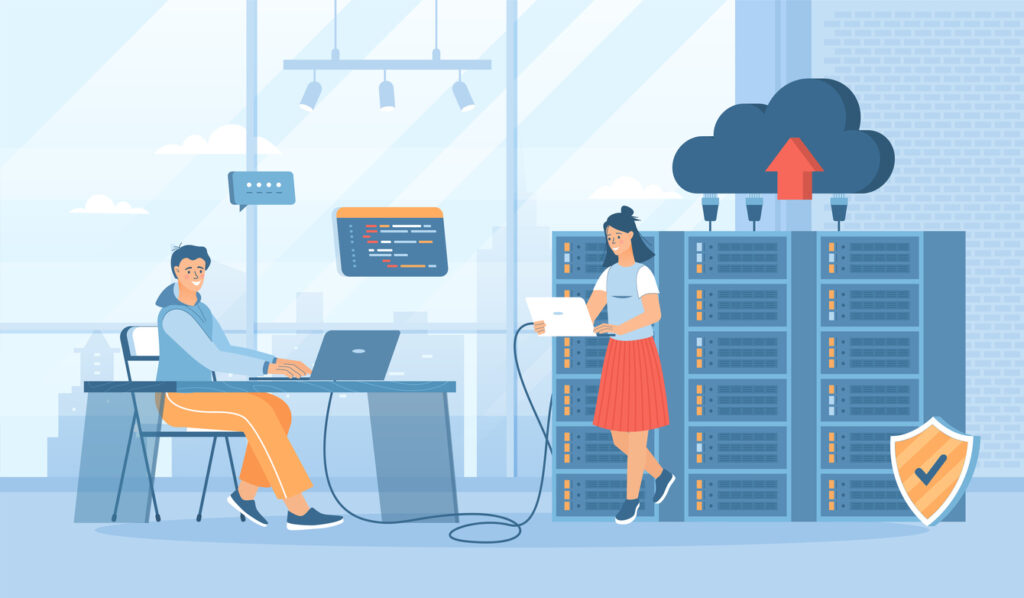
According to Ernst & Young’s survey conducted among American board directors, cybersecurity and data privacy were among the top five board priorities for 2023. Such a focus is indeed justifiable, considering the global average data breach cost, which is $4.45 million as of 2023.
One of the solutions on the way to establishing a secure environment for confidential data management and sharing is a virtual data room (VDR).
This article explains what a virtual data room is, how it is different from a physical data room and cloud storage, and what data room features are essential for your business needs.
What is a virtual data room?
| A virtual data room (VDR) is a secure online repository designed for storing, managing, and sharing sensitive documents during critical business processes. |
Unlike traditional data rooms, best VDR providers offer the advantage of remote access, allowing authorized users to collaborate and share sensitive documents from anywhere. VDRs are considered more secure than physical storage, as they eliminate risks associated with document loss, damage, or unauthorized access during transit.
VDRs are primarily used in high-stakes business activities such as M&A, strategic partnerships, initial public offerings (IPOs), investment negotiations, and audits.
Unlike Google Drive, top virtual data rooms have sophisticated security features, which allow for granular control over document permissions. Thanks to this, actions like printing, forwarding, or copying are often restricted to safeguard sensitive information.
As cybersecurity concerns are expected to grow in 2025 and beyond due to increasing data breaches, cloud-based attacks, and Business Email Compromise (BEC), VDR providers respond by implementing sophisticated security measures, including encryption, multi-factor authentication, and document watermarks.
In addition to basic file sharing, VDRs provide enhanced security features, which make them the preferred solution for industries that require the highest level of data protection during the exchange and review of critical business documents.
Popular data rooms
Overall rating:
4.9/5
Excellent

Overall rating:
4.8/5
Excellent

Overall rating:
4.7/5
Excellent
What is a virtual data room used for?
Generally, virtual data rooms can be used in any situation where high security and privacy of data is required. Additionally, online data rooms are used when there‘s a need for multiple parties to have access to large volumes of data.

Among the main use cases of virtual data rooms are the following:
- Mergers and acquisitions (M&A). This is the most common use case for virtual data rooms, since during M&A transactions lots of confidential information is disclosed to third parties and data security is of paramount importance. The sell-side and buy-side of the deal can prepare and review due diligence documents and effectively collaborate online via a virtual data room. Such an approach can significantly accelerate the deal.
- Fundraising. To attract potential investors and get a business fundraising, startups or companies that seek growth need to disclose large amounts of sensitive information. Additionally, the way this data is organized also matters. That‘s why many businesses choose virtual data rooms to conduct due diligence during a fundraising round.
- Strategic partnerships. Virtual data rooms are also often used when two or more companies want to arrange a strategic alliance. Just like with mergers or acquisitions, during strategic partnerships companies need to share a lot of confidential and sensitive corporate data with third parties. That‘s exactly when virtual data rooms can be extremely helpful.
- Initial public offering (IPO). During an IPO deal, a company that wants to go public is subject to lots of extra rules and regulations at the local, federal, and state levels. Besides, it needs to become more transparent for prospective shareholders and the public in general. In such a situation, the security of sensitive information and the ability to easily organize and distribute large volumes of data is essential, and a virtual data room can help with it.
- Audit. During an audit process, a company needs to disclose lots of confidential information and sensitive documents to lawyers, auditors, and accountants. A virtual data room ensures that such a disclosure does no harm to the company and all the sensitive data is kept private and secure.
- Board communications. Often, board members are heavily involved in the company‘s operations and need to be able to access and review all the key information about the business. Being typically scattered around the world, board directors can easily access all the documentation via a virtual data room, which reduces the need to regularly travel to the physical office.
- Corporate data storage. The most common and obvious way of using a virtual data room is for storing corporate data securely. Data rooms are used in any situation where lots of data needs to be stored in a secure online environment and distributed among many parties.
Top 5 VDR benefits
Using a virtual data room offers numerous benefits for businesses and organizations, making it an indispensable tool in today’s digital landscape. Here are some of the key advantages:
- Enhanced security and compliance: Virtual data rooms provide a secure and controlled environment for sharing confidential files and documents. With advanced security measures like encryption, multi-factor authentication, and permission-based access, VDRs ensure that sensitive data is protected from unauthorized access. This level of security is crucial during the due diligence process and other secure transactions.
- Increased efficiency: VDRs enable real-time collaboration and commenting on files and projects, streamlining the due diligence process and reducing the time and effort required to complete business transactions. This efficiency is particularly beneficial during mergers and acquisitions, where timely access to information can significantly impact the outcome.
- Improved organization: Thanks to implementation of AI in today’s data rooms, organization of documents in VDRs becomes seamless. This organization makes it easier to locate and access the information needed to complete business transactions, reducing the risk of errors and ensuring that all parties have the most up-to-date information.
- Cost savings: By eliminating the need for traditional data rooms, VDRs reduce the costs associated with printing, shipping, and storing documents. This cost-effectiveness is especially advantageous for startups and small businesses that need to manage their resources carefully.
- Scalability: Virtual data rooms can be easily scaled up or down to meet the needs of businesses and organizations, making them an ideal solution for companies of all sizes. Whether you’re a small business or a large corporation, VDRs can adapt to your requirements, providing the flexibility needed to handle varying volumes of data.
What functionality should a data room have?
Modern virtual data rooms offer various features that make the process of data storage and sharing secure and efficient.
Below is the list of all the features a reliable virtual data room should have:
Document security:
- Document access restrictions: Control who can view, manage, collaborate, and download documents. Restrict access whenever needed.
- TLS Encryption: Protect data during transmission within and outside the VDR.
- Content backup: Ensure regular backups of sensitive information for data safety.
- Multi-factor authentication (MFA): Ensure only authorized users can access documents.
- Mobile device access: Enable secure document access via mobile devices.
- Security protocols integration: Use virus scanning, advanced threat protection, and data loss prevention.
- Watermarking: Apply digital watermarks to documents for added security.
- Self-destructing documents: Set security features letting documents expire or self-destruct after a certain period or event.
Document tracking:
- View tracking: Track who has viewed a document and when.
- Access history: Monitor to whom documents are shared and whether they’ve been opened.
- Time spent tracking: Record how long a user spent reviewing a document.
- Popularity tracking: Identify which documents are viewed the most.
- Update notifications: Receive alerts when users upload new documents or make changes.
- Audit reports: Generate compliance reports based on tracked document activity.
Usability:
- Microsoft Office & Google integration: Use seamless integrations with Word, Excel, PowerPoint, OneDrive, and Google tools.
- Advanced search: Allow users to find documents quickly through keyword searches.
- Bulk uploads: Enable large files to be uploaded at once.
- Drag-and-drop functionality: Simplify file uploads by dragging documents directly into the data room.
- Help section: Use tutorials or FAQs for easy user navigation.
- Multilingual access: Get data room access in multiple languages, which is especially helpful when collaborating with numerous parties across the globe.
- Single Sign-On (SSO): Simplify secure login for users.
- Optical Character Recognition (OCR): Locate any important documents and everyday files easily, with no need for manual search.
User management:
- User permission levels: Assign different access rights for viewing, editing, sharing, and downloading documents.
- Bulk user invitation: Invite and manage users in bulk.
- Group setup: Organize users into groups with defined access levels and functions.
- Restricted viewing: Limit user access to specific documents.
What is the difference between a traditional data room and a virtual data room?
What is a physical data room?
A physical data room is a secure, physical space set up by the seller during a merger or acquisition (M&A) to store critical business documents. This room is a key part of the due diligence process, where buyers, along with their legal and financial advisors, can review sensitive information about the company before finalizing the transaction.
Buyers need to access detailed data about the target company to make informed decisions, and the seller organizes all relevant documents in a central location. The room is closely monitored to ensure only authorized personnel can enter, and usually, access is granted to one potential buyer at a time, accompanied by their team, to maintain document confidentiality and integrity.
In contrast to physical, a virtual data room provider is a secure online space that provides a protected environment for storing, sharing, and managing highly sensitive data. Unlike physical data rooms, virtual deal rooms allow multiple users to access files simultaneously from any location via a secure internet connection. This is particularly useful during M&A or venture capital transactions, where the efficient due diligence process requires efficient and secure information sharing.
VDRs are more cost-effective and flexible than traditional data rooms, offering features like multi-factor authentication, customizable permissions, and built-in collaboration tools like Q&A and notes.
You can dive deeper into the difference between a virtual data room and a physical one here.
What is the difference between cloud storage and a virtual data room?
Google Drive is a popular, user-friendly platform widely used for everyday document storage, sharing, and collaboration. It integrates seamlessly with Google Workspace, allowing users to work in real-time on documents, spreadsheets, and presentations.
With features like 15GB of free storage, real-time collaboration, and integration across devices, Google Drive is ideal for general use. However, it lacks the advanced security features necessary for businesses dealing with highly sensitive documents, such as financial data, intellectual property, or legal records. While Google Drive offers encryption and two-factor authentication, it does not provide granular access controls, dynamic watermarking, or a full audit trail, which are essential in high-stakes environments like M&A.
In contrast, virtual data room providers are designed specifically for storing and managing sensitive information during complex transactions like mergers and acquisitions or due diligence processes. VDRs provide advanced encryption, role-based access control, and detailed audit logs for and many other essential features, which makes it vital for industries that require regulatory compliance, such as finance, healthcare, and real estate. Unlike Google Drive, VDRs allow companies to control all data room activity, knowing exactly who can access, edit, or download specific documents and ensuring data security at every stage of a transaction.
You can dive deeper into the difference between a virtual data room and cloud storage here.
Are there any alternatives to a VDR?
Now, let‘s take a look at how exactly virtual data rooms are different from cloud storage and physical data rooms based on the features they provide.
- Disclaimer: This comparative table presents the collective results of our review of the most popular cloud storage solutions and a typical physical data room.
| Virtual data room | Cloud storage | Physical data room | |
| Secure document sharing | Yes | Partially | Questionable |
| Real-time reporting | Yes | Yes | No |
| Time and IP access restrictions | Yes | No | No |
| Remote shred and wipe | Yes | Yes | No |
| Secure fence view | Yes | No | No |
| Notifications | Yes | Yes | No |
| Access to multiple parties | Yes | Yes | Yes |
| Large volumes of data | Yes | Yes | Yes |
| Customization and branding | Yes | Sometimes | Questionable |
| Mobile devices support | Yes | Yes | No |
| 24/7 support | Yes | Yes | No |
| Time savings | Yes | Yes | No |
| Cost savings | Yes | Yes | No |
As we can see from the comparison results, physical data rooms are definitely an outdated data-storing solution. While cloud storage can also offer many modern services for security and effective collaboration, it still can‘t provide the virtual data rooms‘ level of security.
Conclusion
In 2024, virtual data room providers have solidified their role in the data management market, especially for businesses handling sensitive information in critical transactions like M&A, IPOs, and fundraising.
Unlike traditional data rooms or general cloud storage services like Google Drive, VDRs offer advanced security features, including multi-factor authentication, dynamic watermarking, and granular access settings, making them crucial for industries that require stringent data protection and regulatory compliance.
With real-time collaboration features, detailed audit trails, and 24/7 support, VDRs ensure secure sharing of confidential documents, providing a cost-efficient solution for today’s data-sharing needs.


